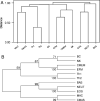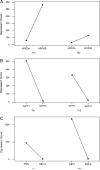A phylogenetic approach to gene expression data: evidence for the evolutionary origin of mammalian leukocyte phenotypes
- PMID: 19601972
- PMCID: PMC2810715
- DOI: 10.1111/j.1525-142X.2009.00345.x
A phylogenetic approach to gene expression data: evidence for the evolutionary origin of mammalian leukocyte phenotypes
Abstract
The evolution of multicellular organisms involved the evolution of specialized cell types performing distinct functions; and specialized cell types presumably arose from more generalized ancestral cell types as a result of mutational event, such as gene duplication and changes in gene expression. We used characters based on gene expression data to reconstruct evolutionary relationships among 11 types of lymphocytes by the maximum parsimony method. The resulting phylogenetic tree showed expected patterns including separation of the lymphoid and myeloid lineages; clustering together of granulocyte types; and pairing of phenotypically similar cell types such as T-helper cells type 1 and T-helper cells type 2 (Th1 and Th2). We used phylogenetic analyses of sequence data to determine the time of origin of genes showing significant expression difference between Th1 and Th2 cells. Many such genes, particularly those involved in the regulation of gene expression or activation of proteins, were of ancient origin, having arisen by gene duplication before the most recent common ancestor (MRCA) of tetrapods and teleosts. However, certain other genes with significant expression difference between Th1 and Th2 arose after the tetrapod-teleost MRCA, and some of the latter were specific to eutherian (placental) mammals. This evolutionary pattern is consistent with previous evidence that, while bony fishes possess Th1 and Th2 cells, the latter differ phenotypically in important respects from the corresponding cells of mammals. Our results support a gradualistic model of the evolution of distinctive cellular phenotypes whereby the unique characteristics of a given cell type arise as a result of numerous independent mutational changes over hundreds of millions of years.
Figures






Similar articles
-
Suppressors of cytokine signaling proteins are differentially expressed in Th1 and Th2 cells: implications for Th cell lineage commitment and maintenance.J Immunol. 2002 Apr 1;168(7):3181-7. doi: 10.4049/jimmunol.168.7.3181. J Immunol. 2002. PMID: 11907070
-
Differential evolution of voltage-gated sodium channels in tetrapods and teleost fishes.Mol Biol Evol. 2011 Jan;28(1):859-71. doi: 10.1093/molbev/msq257. Epub 2010 Oct 5. Mol Biol Evol. 2011. PMID: 20924084
-
The relaxin family peptide receptors and their ligands: new developments and paradigms in the evolution from jawless fish to mammals.Gen Comp Endocrinol. 2014 Dec 1;209:93-105. doi: 10.1016/j.ygcen.2014.07.014. Epub 2014 Jul 29. Gen Comp Endocrinol. 2014. PMID: 25079565 Review.
-
Molecular pathway profiling of T lymphocyte signal transduction pathways; Th1 and Th2 genomic fingerprints are defined by TCR and CD28-mediated signaling.BMC Immunol. 2012 Mar 14;13:12. doi: 10.1186/1471-2172-13-12. BMC Immunol. 2012. PMID: 22413885 Free PMC article.
-
Control of cytokine gene transcription in Th1 and Th2 cells.Clin Exp Allergy. 2008 Sep;38(9):1422-31. doi: 10.1111/j.1365-2222.2008.03067.x. Epub 2008 Jul 19. Clin Exp Allergy. 2008. PMID: 18647314 Review.
Cited by
-
Evolutionary hallmarks of the human proteome: chasing the age and coregulation of protein-coding genes.BMC Genomics. 2016 Oct 25;17(Suppl 8):725. doi: 10.1186/s12864-016-3062-y. BMC Genomics. 2016. PMID: 27801289 Free PMC article.
-
Integrating phylogenies into single-cell RNA sequencing analysis allows comparisons across species, genes, and cells.PLoS Biol. 2024 May 24;22(5):e3002633. doi: 10.1371/journal.pbio.3002633. eCollection 2024 May. PLoS Biol. 2024. PMID: 38787797 Free PMC article.
-
Cell type evolution reconstruction across species through cell phylogenies of single-cell RNA sequencing data.Nat Ecol Evol. 2024 Feb;8(2):325-338. doi: 10.1038/s41559-023-02281-9. Epub 2024 Jan 5. Nat Ecol Evol. 2024. PMID: 38182680
-
Multi-resolution characterization of molecular taxonomies in bulk and single-cell transcriptomics data.Nucleic Acids Res. 2021 Sep 27;49(17):e98. doi: 10.1093/nar/gkab552. Nucleic Acids Res. 2021. PMID: 34226941 Free PMC article.
-
Parallelized multidimensional analytic framework applied to mammary epithelial cells uncovers regulatory principles in EMT.Nat Commun. 2023 Feb 8;14(1):688. doi: 10.1038/s41467-023-36122-x. Nat Commun. 2023. PMID: 36755019 Free PMC article.
References
-
- Bilic I, Ellmeier W. The role of BTB domain-containing zinc finger proteins in T cell development and function. Immunol. Lett. 2007;108:1–9. - PubMed
-
- Bruni P, et al. Fe65, a ligand of the Alzheimer's β-amyloid precursor protein, blocks cell cycle progression by down-regulating thymididate synthase expression. J. Biol. Chem. 2002;277:35481–35488. - PubMed
-
- Callard RE, Gearing AJ. The Cytokine Factsbook. Academic Press; London: 1994.
Publication types
MeSH terms
Grants and funding
LinkOut - more resources
Full Text Sources

